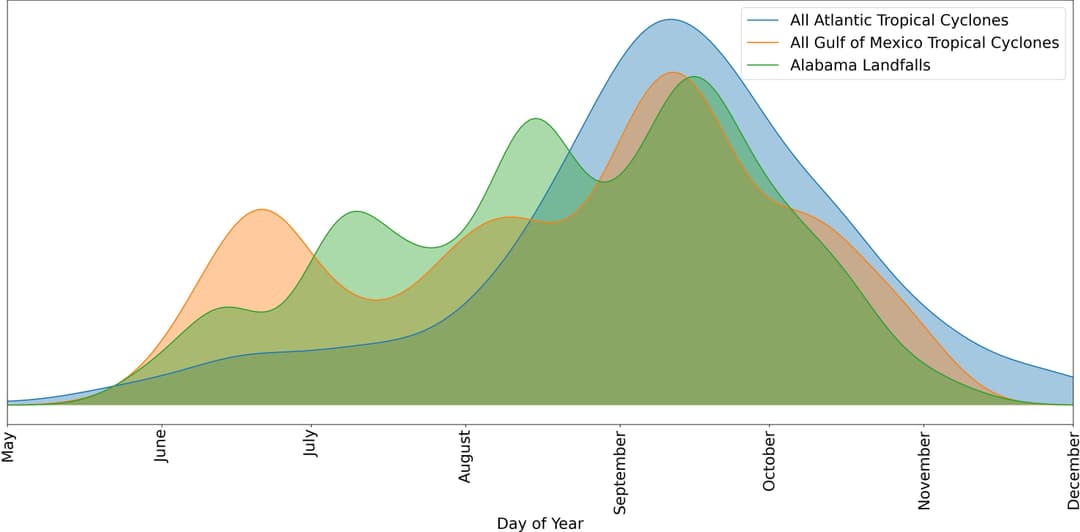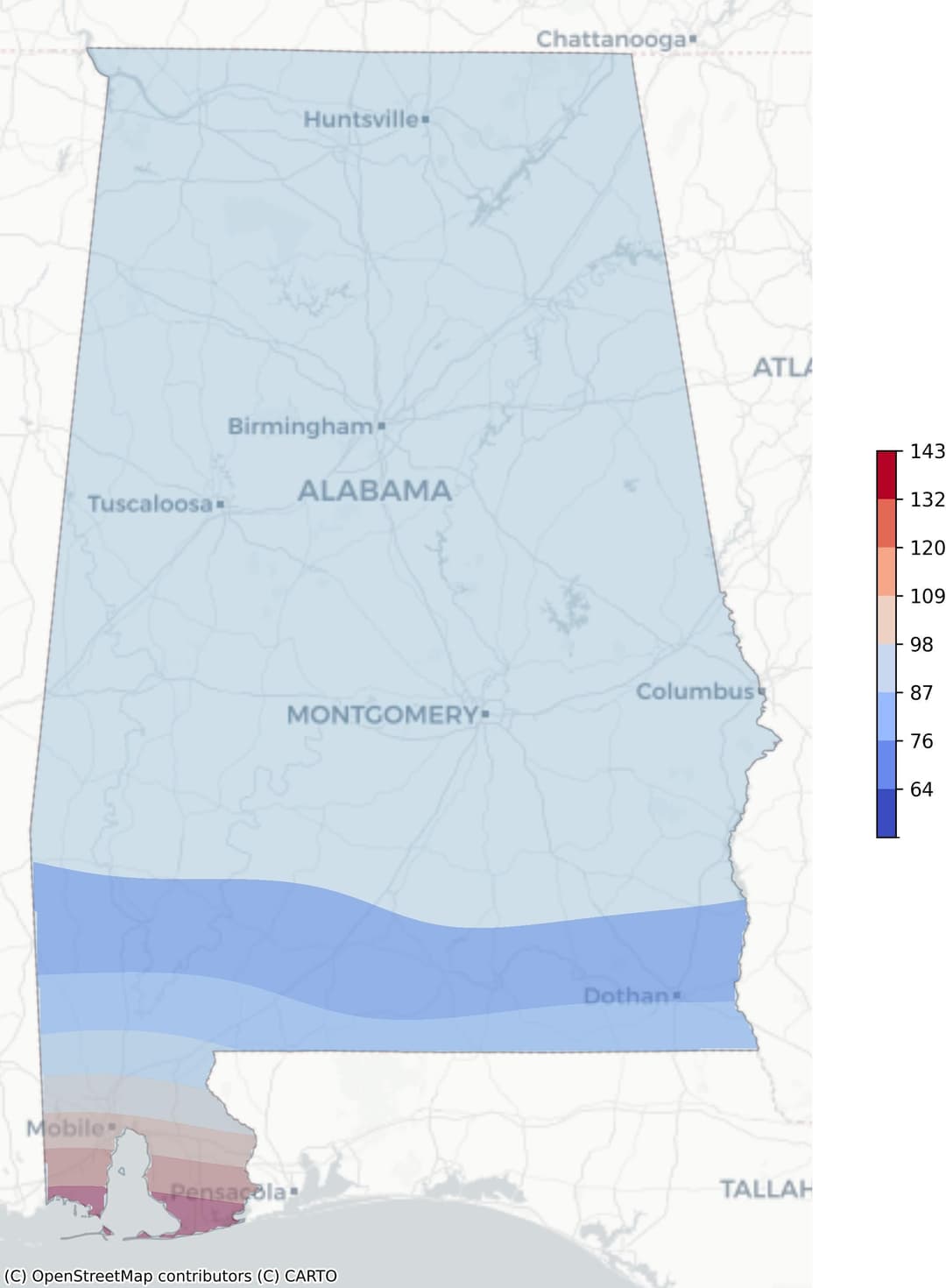Hurricanes in Alabama
When is Hurricane Season in Alabama?
The official hurricane season in Alabama follows the Atlantic hurricane season, running from June 1st through November 30th. During this period, Alabama is susceptible to tropical cyclones, including tropical depressions, tropical storms, and hurricanes.
The National Hurricane Center tracks these weather phenomena and issues warnings as necessary. Compared to other U.S states, Alabama experiences a significant number of storms. However, it ranks behind Florida, Texas, and Louisiana in terms of the frequency of major hurricanes.

The graph above[1] illustrates the frequency of hurricanes in Alabama based on historical storm data from 1851. It compares daily probabilities of Atlantic basin hurricanes, Gulf of Mexico-originated storms, and actual landfalls of tropical storms in Alabama. The raw data used for this graph was obtained from the NOAA Hurricane Research Division.
The graph reveals a clear spike in tropical storm activity around June, which is characteristic of hurricane season in the Gulf of Mexico sub-basin. This early storm activity can be attributed to the Gulf's warm waters, which provide heat energy for storm development.
A notable example of a Gulf-originated storm is Hurricane Audrey in 1957, which rapidly intensified in the Gulf before making landfall in Texas and Louisiana. The storm eventually moved inland and caused 18 tornadoes in Alabama and Mississippi.
Hurricanes are most likely to occur in September. While the season peaks between August and October, you're statistically most likely to encounter a tropical cyclone on September 10. However, the risk of hurricanes outside the official season persists due to Alabama's proximity to the Gulf of Mexico. According to Texas A&M University, early-formed Gulf hurricanes can be devastating.
Where do Hurricanes hit the most in Alabama?
The most hurricane-prone areas within Alabama are predominantly along the coastline, specifically in Mobile and Baldwin counties. These areas are particularly susceptible due to their proximity to the Gulf of Mexico, which is a common origin point for Atlantic hurricanes, as mentioned by SAMHSA.

The graph shown above illustrates the frequency and intensity of hurricanes across Alabama. The heatmap ranges from blue to red, with blue indicating areas with less frequent and lower intensity hurricanes and red indicating areas with more frequent and higher intensity hurricanes.
According to the Baldwin County report, the highest risk zones, marked in red, are most exposed to hurricane-force winds and are at an elevated risk for storm surges and flood conditions.
What Are The Recent Hurricanes in Alabama?
Hurricane Zeta (2020): Zeta caused widespread damage across southern Alabama, significantly impacting Baldwin and Mobile Counties. In Clarke County, one fatality occurred due to a falling tree. The National Centers for Environmental Information (NCEI) estimated approximately $840 million in damages across the state.
Hurricane Sally (2020): Sally was a slow-moving hurricane that produced significant damage in Alabama, particularly in Mobile an d Baldwin Counties. Power lines, trees, and buildings suffered widespread damage, and the Alabama Forestry Commission reported over $1.5 million worth of timber destroyed. The NCEI estimates Sally caused $7.3 billion in damages in the United States, mainly in Alabama and the Florida Panhandle.
Hurricane Michael (2018): While Michael primarily affected Florida, Georgia, and North Carolina, it also impacted Alabama. The hurricane directly caused 16 deaths.
Hurricane Katrina (2005): Katrina had widespread economic and environmental ramifications. The hurricane caused significant damage to the oil and gas industry and transportation. In Alabama, an oil rig under construction along the Mobile River was dislodged, causing extensive damage.
Hurricane Ivan (2004): Ivan was the most destructive hurricane to affect Alabama in over 100 years. The Alabama Forestry Commission found damaged timber valued at about $610 million on 2.7 million acres. Ivan caused widespread power outages and home damage, leaving over 1.8 million people without power in nine states.
How to Prepare for A Hurricane Season in Alabama
In regions like Alabama, where hurricanes are not uncommon, adequate preparation can be the difference between life and death. A well-executed plan can help protect lives, safeguard property, and hasten recovery after the storm.
Before a Hurricane
When it comes to hurricane preparedness, being proactive is key. A comprehensive hurricane preparation checklist can help you ensure that you're ready when a storm is on the horizon. Here are some critical steps to consider:
- Stay informed: Keep up-to-date with the latest weather forecasts and warnings from reliable sources. Knowing when a hurricane is likely to hit gives you time to prepare.
- Secure your home: Install storm shutters or board up windows to prevent damage. Secure loose items in your yard to prevent them from becoming dangerous projectiles.
- Stock up on supplies: Ensure you have enough food, water, and essential supplies to last at least a week. Remember to include necessary items like medications, pet food, and baby supplies.
- Create a disaster plan: Know where you will go if you need to evacuate. Make sure every member of your family understands the plan.
- Prepare your emergency kit: This should include flashlights, batteries, first aid supplies, cash, important documents, and a battery-operated radio.
Remember, hurricane safety is paramount. It's better to be over-prepared than under-prepared when a hurricane is imminent.
During a Hurricane
The safety measures to be undertaken during a hurricane are critical. The following points outline actions to prepare for a hurricane:
- Stay updated with the latest information from reliable sources such as the National Weather Service.
- Evacuate if advised by local authorities. Avoid flooded roads and watch for washed-out bridges.
- If not evacuated, stay indoors, preferably in a small, windowless, and centrally located room.
- Stay away from glass doors and windows to avoid getting injured by flying debris.
- Turn off utilities if instructed by authorities to prevent damage.
- Do not use electrical equipment or telephones as they increase the risk of attracting lightning.
- Have a battery-powered weather radio to receive updates about the hurricane.
After a Hurricane
Knowing what to do after a hurricane can help you recover faster and ensure your family's safety. Here's a brief list of actions to take:
- First, ensure the safety of all family members and pets. Check for injuries and get medical attention if necessary.
- Second, once it's safe to return, assess the damage to your home and property. Document everything with photos or videos for insurance purposes.
- Third, file an insurance claim as soon as possible. Provide all necessary documentation and cooperate with the insurance adjuster.
- Fourth, clean up the property to prevent further damage. This includes removing water, drying out items, and disposing of damaged items.
- Fifth, contact the Federal Emergency Management Agency (FEMA) to see if you qualify for disaster assistance. This can help cover costs not covered by insurance.
- Finally, repair and rebuild. This might involve hiring contractors, obtaining necessary permits, and ensuring all work is up to code.
[1]: The graph has been smoothed using a Gaussian smoothing function to better highlight the trends.